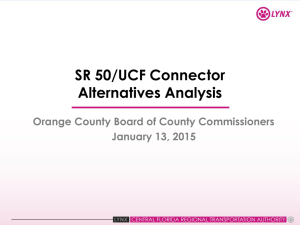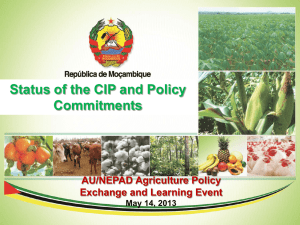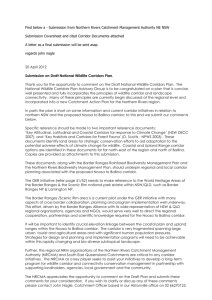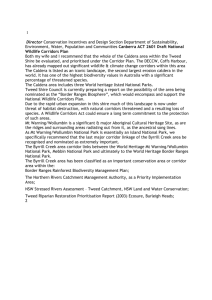Project Description This report comprises activities developed within
advertisement
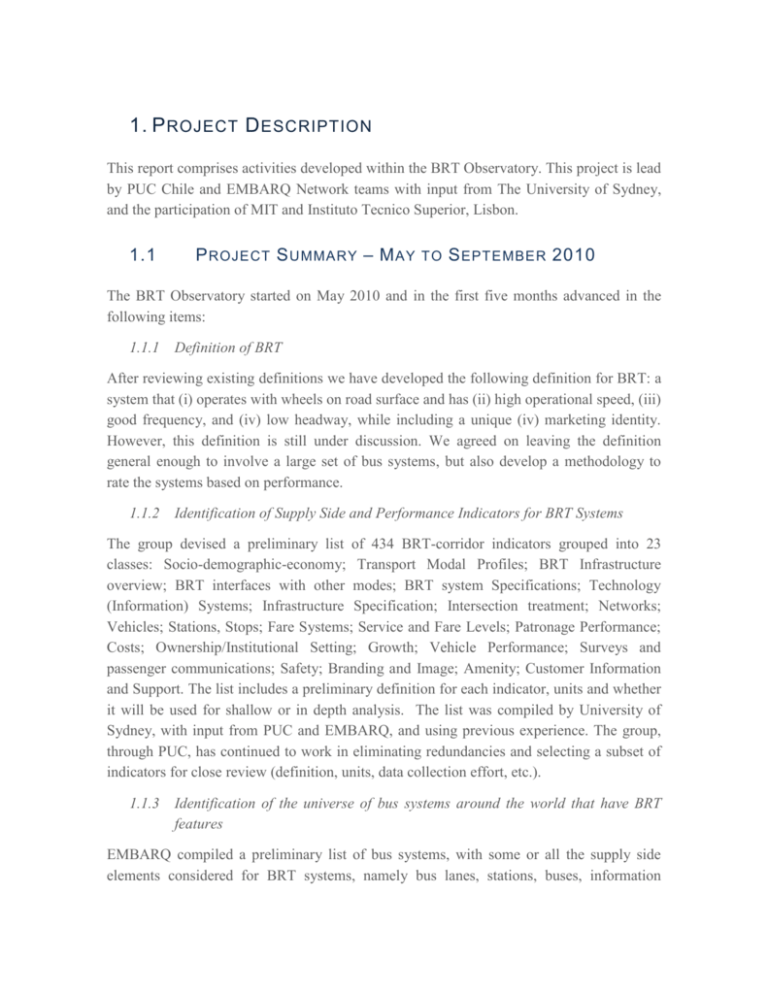
1. P ROJECT D ESCRIPTION This report comprises activities developed within the BRT Observatory. This project is lead by PUC Chile and EMBARQ Network teams with input from The University of Sydney, and the participation of MIT and Instituto Tecnico Superior, Lisbon. 1.1 P ROJECT S UMMARY – M AY TO S EPTEMBER 2010 The BRT Observatory started on May 2010 and in the first five months advanced in the following items: 1.1.1 Definition of BRT After reviewing existing definitions we have developed the following definition for BRT: a system that (i) operates with wheels on road surface and has (ii) high operational speed, (iii) good frequency, and (iv) low headway, while including a unique (iv) marketing identity. However, this definition is still under discussion. We agreed on leaving the definition general enough to involve a large set of bus systems, but also develop a methodology to rate the systems based on performance. 1.1.2 Identification of Supply Side and Performance Indicators for BRT Systems The group devised a preliminary list of 434 BRT-corridor indicators grouped into 23 classes: Socio-demographic-economy; Transport Modal Profiles; BRT Infrastructure overview; BRT interfaces with other modes; BRT system Specifications; Technology (Information) Systems; Infrastructure Specification; Intersection treatment; Networks; Vehicles; Stations, Stops; Fare Systems; Service and Fare Levels; Patronage Performance; Costs; Ownership/Institutional Setting; Growth; Vehicle Performance; Surveys and passenger communications; Safety; Branding and Image; Amenity; Customer Information and Support. The list includes a preliminary definition for each indicator, units and whether it will be used for shallow or in depth analysis. The list was compiled by University of Sydney, with input from PUC and EMBARQ, and using previous experience. The group, through PUC, has continued to work in eliminating redundancies and selecting a subset of indicators for close review (definition, units, data collection effort, etc.). 1.1.3 Identification of the universe of bus systems around the world that have BRT features EMBARQ compiled a preliminary list of bus systems, with some or all the supply side elements considered for BRT systems, namely bus lanes, stations, buses, information technology, service and branding. The preliminary list encompasses 120 cities with BRT and Bus Corridors. These BRT corridors will be observed under the shallow set of indicators. The initial list with data was used to prepare the report “Status of the BRT Industry”, which was presented to the CoE Members and Advisors on January, 2011. The initial list was also used in presentations and paper submissions (see appendix). 1.1.4 Identification of cities for deep analysis A list of 16 cities has been suggested for “in-depth” review; seven from Latin America, two from Asia, three from Europe, 1 from Africa, two from Australia and two from US and Canada. 1.2 P ROJECT S UMMARY – O CT 2010 TO S EPT 2011 BRT Observatory: O1) Define a framework for PT systems, O2) Develop a methodology to gather field information for the Observatory, O3) Select a set of cities for data collection at two levels of detail: deep and shallow, O4) Implement the methodology and collect the information, O5) Create and provide a benchmark report, O6) Case Studies. The level of advance is presented as follows. 1.2.1 Observatory Pilot Questionnaire – Shallow indicators The objective of this activity was to capture and record the experience of elaborating and filling up the Shallow Indicator Observatory Pilot Questionnaire pertaining to the BRT Observatory. This first effort was based on the application of the questionnaire to four Bus Rapid Transit (BRT) corridors: Linha Verde (Curitiba, Brazil), Optibús (León, Mexico), Trolebus (Quito, Ecuador), and Pajaritos Sur (Santiago de Chile, Chile). INDICATORS AND QUESTIONS EMBARQ Network, ITLS, and PUC-Chile agreed on a set of 121 indicators. EMBARQ, through EMBARQ Brasil, was responsible for elaborating a clear and user friendly platform to compile and analyze all the data collected. The pilot questionnaire ended up with 180 questions. From October 15th to November 29th 2010 a total of 191 person-hours (EMBARQ Brasil) were invested in the edition of two versions of the pilot questionnaire: VREF 1.0_ pilot questionnaire_12nov: 149 questions VREF 1.1_ pilot questionnaire_29nov: 180 questions (including the ones proposed by ITLS for the BRT-ALC Laboratory Strategic Project 1 LS1) PILOT BRT CORRIDORS Four corridors were selected to test the Observatory Pilot Questionnaire (VREF 1.1). The selection was based on two principles: Test how many answers we could get from cities/systems we have good relations and are close enough to grab field data if needed (Curitiba and Santiago). Test how much information we could get from cities/systems where we do not have substantive local presence and/or a contact person to help us out (León and Quito). DATA COLLECTION Data collection started on November 29th on the four cities. EMBARQ Brasil collected data for Curitiba, CTS-México for León and PUC-Chile for Quito and Santiago. Linha Verde Bus Rapid Transit Corridor – Curitiba, Brazil 156/180 answered questions from one corridor total of 169 person-hours dedicated to data collection trip to Curitiba (URBS) to explain the project and facilitate data sharing Optibús Bus Rapid Transit System – León, Mexico 121/180 answered questions from five corridors total of 64 person-hours dedicated to data collection Trolebus Bus Rapid Transit Corridor – Quito, Ecuador 151/180 answered questions from one corridor Pajaritos Sur Bus Rapid Transit Corridor – Santiago de Chile, Chile 116/180 answered questions from one corridor AVAILABILITY MEASURES Measures the degree to which the information requested as part of the indicators was available and the type of source used. The following categories were used to evaluate the difficulty on getting the data in Curitiba, León and Santiago: Availability Category Indicated As… Could Not Get CNG Very Hard to Get VHG Difficult to Get DG Straightforward to Get SG Description The information was not available through any available sources (publications, internet, emails, direct contact, etc.) The information was not available through public (i.e. internet, publications, etc.) sources, it was however available through direct contact but not possible to obtain within a reasonable effort (2 weeks) The information could not be found in most cases using internet or additional sources within a reasonable amount of time (more than 40 minutes per question) The information was obtained within a reasonable amount of time and effort (less than 40 minutes per question) Linha Verde Bus Rapid Transit Corridor – Curitiba, Brazil 156/180 questions answered for one corridor The following graph represents the proportion of questions that pertained to each of the four categories defined previously. 2% 34% SG DG VHG 60% 4% CNG Optibús Bus Rapid Transit System – León, Mexico 121/180 questions answered for five corridors The following graph represents the proportion of questions that pertained to each of the four categories defined previously. 1% 26% 36% SG DG VHG 37% CNG Trolebus Bus Rapid Transit Corridor – Quito, Ecuador 151/180 questions answered for one corridor No information available for composing the graph. Pajaritos Sur Bus Rapid Transit Corridor – Santiago de Chile, Chile 116/180 questions answered for 1 corridor The following graph represents the proportion of questions that pertained to each of the four categories defined previously. 36% 42% SG DG VHG 22% AVAILABILITY OF INFORMATION According to the graph below, more than half of the information required was available for all corridors analyzed. On the other hand, around 17% of the information was not available for more than half of the corridors and had to be rethought. 14% 3% available for all the corridors available for 3 corridors 16% available for 2 corridors available for 1 corridor 10% unavailable for all the corridors 57% MAIN FINDINGS As expected, increasing amount of time was required to answer the most difficult questions. This implies that (a) the pilot questionnaire could not be completely filled up using internet sources, and (b) if a complete list is required, a lot of time would have to be devoted to obtain a 100% response rate. Some indicators were very hard to get, and some of them none of the four teams could obtain within a reasonable effort. We needed to revisit the set of shallow indicators that would be part of the final questionnaire. Some information is not available on a per corridor basis; it belongs to the whole system of corridors within the city (e.g. subsidy for the system, population of the catchment area). We needed to define some system indicators to be able to capture the required information. We had to improve the excel spreadsheet. We faced difficulties when dealing with 4 corridors, and believe it would be very hard to keep 100+ BRT corridors in that current format. Managing pictures in an excel platform is one of the difficulties. As a main result, we redefined the scope of the information to be captured in three levels: 1.2.2 Basic level was created, comprising 68 very basic information on cities for 100+cities, 300+ corridors. Indicators previously called shallow are now part of the Medium level set of indicators which are important for econometric analyses. Define dataset (50-60 cities, ~100 corridors) and mechanism to get to medium level indicators (EMBARQ will collect data for 15-20 cities, 30-40 corridors). Detailed information to be compiled for Deep analysis and selection of the cities (EMBARQ will concentrate on 7-8 cities where it has strong contacts). Observatory Basic Questionnaire The objective of this activity was to capture and record the progress of data collection in the Basic level. This effort includes results from 87 corridors across 11 countries: Brazil (58 corridors), Mexico (7 corridors), Chile (7 corridors), Ecuador (5 corridors), India (3 corridors), Guatemala (2 corridors), Panama (1 corridor), Peru (1 corridor), Turkey (1 corridor), Venezuela (1 corridor) and Australia (1 corridor). BASIC INDICATORS EMBARQ-Network (convened with International Energy Agency, IEA) and PUC-Chile agreed on a set of 68 basic indicators to be validated on the basic questionnaire. The indicators are classified into 14 categories: general information, system image, running ways, comfort, system information, ITS, stations, traffic engineering, vehicles, quality of service, corridor info, travel time, services and costs. EMBARQ, thought EMBARQ Brasil, was responsible for elaborating a clear and user friendly platform to compile and analyze all the data collected. From January 24th to February 22nd a total of 110 person-hours (EMBARQ Brasil) were invested in the Basic Questionnaire indicators selection and questionnaire. Since then, data collection is ongoing in 11 countries. Main results are below, divided per country. 1. BRAZIL EMBARQ Brasil identified a total of 25 cities with BRT and bus corridors in Brazil, adding up 78 corridors. This report consolidates data from the first effort in 15 Brazilian cities, adding up 58 corridors: Porto Alegre (12 corridors), São Paulo (10 corridors), Belo Horizonte (7 corridors), Curitiba (6 corridors), Joinville (5 corridors), Campinas (4 corridors), Recife (4 corridors). Salvador (3 corridors), Fortaleza (1 corridor), Goiânia (1 corridor), João Pessoa (1 corridor), Maceió (1 corridor), Natal (1 corridor), Santos (1 corridor) and Uberlândia (1 corridor). These cities were selected for the first year of data collection due to two reasons: (i) availability of data on internet; (ii) together they represent the majority of Brazilian BRT and bus corridors length (more than 400 km). The following picture illustrates Brazilian cities selected for this first effort (in green). DATA COLLECTION Data collection started on February 23rd in the 25 cities. According to the availability of data, we selected the 15 most promising ones to the first year. The data collection effort so far summed 489 hours for 58 corridors, resulting in an average of 78% of response. Work is still in progress in some of the 15 cities, as Joinville for example. Next 10 cities will be included in the database by the coming year. City Number of corridors Belo Horizonte 7 Campinas 4 Curitiba 6 Fortaleza 1 Goiania 1 João Pessoa 1 Joinville 5 Maceió 1 Natal 1 Porto Alegre 12 Recife 4 Salvador 3 Santos 1 São Paulo 10 Uberlândia 1 Total 58 km Answered indicators (%) 24,9 77% 41,8 74% 81,4 85% 2,0 75% 14,0 91% 1,4 77% 15,5 56% 13,0 82% 3,5 85% 55,7 79% 25,1 75% 18,5 77% 2,5 72% 121,6 84% 7,5 87% 428,4 78% AVAILABILITY OF DATA The following table describes the percentage of answered questions in each category for all 15 cities. This table represents the ongoing data collection. Percentages trend to increase. General info 100% System info 84% Corridor info 70% Running ways 97% Traffic engineering 90% Stations 88% Vehicles 67% Services 57% ITS 94% Travel time 36% Comfort 100% Cost 1% Quality of service 98% System image 100% MAIN FINDINGS - It´s very difficult to get costs information from existing bus corridors in Brazil. Bus corridors of Porto Alegre and Curitiba, for example, were first build on the 70s and 80s, with no reliable data about planning and implementation costs. Costs related to Linha Verde, the BRT corridor just inaugurated in Curitiba, diverge from source to source, and a deeper analysis should be done to identify reliable information. - Basic indicators were defined aiming to be answered by internet search or quick contacts with key persons in transit agencies. However, some of them revealed to be very hard to get even with deep conversations. For example, Brazilian agencies do not have information about total length of feeder routes available. - It was not difficult to find local staff responsible for the data we are looking for, but it´s hard to make this person to answer our questions. Most cases we had to call several times to get a feedback. - Different transit agencies collect different indicators for internal analysis. Several times we had to adjust the information they send us to fill out the questionnaire. For example, demand data is frequently associated to each bus operator, and not divided by corridor. The same situation occurs regarding to fleet and bus frequency by corridor. 2. MEXICO This report consolidates data from 5 Mexican cities, adding up 7 corridors: Mexico City (2 corridors + 1 corridor in Distrito Federal), Ecatepec (1 corridor), Guadalajara (1 corridor), León (1 corridor) and Monterrey (1 corridor). The following picture illustrates Mexican cities selected for this study. DATA COLLECTION Data collection started on February 23rd in the 5 cities. The data collection effort resulted in an average of 82% of response. City Number of corridors km Answered indicators (%) Ecatepec Guadalajara León Mexico City + DF Monterrey Total 1 1 1 3 1 7 16,3 16,0 31,0 65,1 15,6 144,0 82% 96% 82% 80% 69% 82% AVAILABILITY OF DATA The following table describes the percentage of answered questions in each category for all cities. General info 100% System info 94% Corridor info 97% Running ways 100% Traffic engineering 100% Stations 90% Vehicles 46% Services 100% ITS 100% Travel time 100% Comfort 100% Cost 49% Quality of service 86% System image 100% MAIN FINDINGS - Some of the data collected from Leon BRT represents the data from the whole system, due to the difficulty to define the routes and corridors. One clear example is the demand: transit agency treats demand by system, so the data provided in the questionnaire is for the entire system. - Most of the data that are incomplete refers to the costs of the BRT or bus corridors. All the cities have the questionnaire almost complete except for costs. 3. CHILE This report consolidates data from one Chilean city, Santiago, with 7 corridors. The following picture illustrates the location of the city selected for this study. DATA COLLECTION Data collection started on February 23rd in Santiago. The data collection effort resulted in an average of 84% of response. City Number of corridors km Answered indicators (%) 7 35,4 84% Santiago AVAILABILITY OF DATA The following table describes the percentage of answered questions in each category. General info 100% System info 100% Corridor info 63% Running ways 100% Traffic engineering 100% Stations 100% Vehicles 63% Services 100% ITS 100% Travel time 100% Comfort 100% Cost 29% Quality of service 100% System image 100% MAIN FINDINGS - The main difficulty with the form was to adjust the information obtained to the questions in the form. The information obtained were averages or aggregate totals, which used to include more routes/lines than the ones operating on the corridor. - Another difficulty was to compute the total length of feeder routes, because there were around 200 of them. This information was obtained by hand using Google Maps, which took a lot of time. Some other pieces of information were easier to obtain by field observation. - Information that is left incomplete: costs, number of buses operating in the corridor, buses performance, numbers of boarding per day, load factor during rush hour. Most of this information could be obtained from the operators. PUC Chile tried to contact them by emails but did not succeed. 4. ECUADOR This report consolidates data from 2 cities from Ecuador, adding up 5 corridors: Quito (3 corridors) and Guayaquil (2 corridors). The following picture illustrates cities selected for this study. DATA COLLECTION Data collection started on February 23rd in the 2 cities. The data collection effort resulted in an average of 92% of response. City Number of corridors km Answered indicators (%) 3 2 5 32,6 36,8 69,4 88% 97% 92% Quito Guayaquil Total AVAILABILITY OF DATA The following table describes the percentage of answered questions in each category for all cities. General info 100% System info 100% Corridor info 96% Running ways 89% Traffic engineering 80% Stations 97% Vehicles 96% Services 80% ITS 93% Travel time 80% Comfort 100% Cost 53% Quality of service 80% System image 100% MAIN FINDINGS - In Quito, the two first corridors, Ecovía and Trolebus, were completed almost entirely, except for the Total planning costs. Regarding the Metrovía corridor, the situation was different, because it is managed by a 5 private operators cooperative, and a lot of the information was left incomplete because the only source was the internet. No personal contact was established. - In Guayaquil, Fundación Metrovia controls both corridors, and a big part of the information they have is aggregated for Troncal 1 and 3. Even with the contact of the President of the Foundation, it was not possible to obtain contacts from the operators, which might have given me more disaggregated info. Total planning costs and Operational costs were not available. Most of the info came from internet and from the President of Metrovia. 5. INDIA This report consolidates data from 3 Indian cities, adding up 3 corridors: Jaipur (1 corridor), New Delhi (1 corridor) and Pune (1 corridor). The following picture illustrates Indian cities selected for this study. DATA COLLECTION Data collection started on February 23rd in the 3 cities. The data collection effort resulted in an average of 97% of response. City Jaipur New Delhi Pune Total Number of corridors km Answered indicators (%) 1 1 1 3 7,1 5,8 17,0 29,9 100% 95% 97% 97% AVAILABILITY OF DATA The following table describes the percentage of answered questions in each category for all cities. General info 100% System info 100% Corridor info 100% Running ways 100% Traffic engineering 100% Stations 100% Vehicles 99% Services 100% ITS 100% Travel time 100% Comfort 100% Cost 58% Quality of service 100% System image 100% MAIN FINDINGS - As other countries, in India was also hard to find information regarding to costs. 6. GUATEMALA This report consolidates data from 1 city from Guatemala, the city of Guatemala, comprising 2 corridors. The following picture illustrates the city selected for this study. DATA COLLECTION Data collection started on February 23rd on Guatemala. The data collection effort resulted in an average of 91% of response. City Number of corridors km Answered indicators (%) 2 29,8 91% Guatemala AVAILABILITY OF DATA The following table describes the percentage of answered questions in each category. General info 100% System info 90% Corridor info 90% Running ways 100% Traffic engineering 100% Stations 100% Vehicles 89% Services 100% ITS 100% Travel time 100% Comfort 100% Cost 25% Quality of service 100% System image 100% MAIN FINDINGS - As other countries, in Guatemala was also hard to find information regarding to costs. 7. PANAMA This report consolidates data from 1 city from Panama, the city of Panama, one corridor. The following picture illustrates the city selected for this study. DATA COLLECTION Data collection started on February 23rd in Panama. The data collection effort resulted in an average of 59% of response. City Number of corridors km Answered indicators (%) 1 28,1 59% Panama AVAILABILITY OF DATA The following table describes the percentage of answered questions in each category. General info 88% System info 40% Corridor info 60% Running ways 100% Traffic engineering 100% Stations 83% Vehicles 14% Services 100% ITS 100% Travel time Comfort Cost 0% 100% 0% Quality of service 100% System image 100% MAIN FINDINGS - Panama was the city where we got the minor response. Main lack of information regards on costs, travel times and vehicles characteristics. 8. PERU This report consolidates data from one Peruvian city, Lima, with one corridor. The following picture illustrates the city selected for this study. DATA COLLECTION Data collection started on February 23rd in Lima. The data collection effort resulted in an average of 91% of response. City Number of corridors km Answered indicators (%) 1 26,0 91% Lima AVAILABILITY OF DATA The following table describes the percentage of answered questions in each category. General info 88% System info 100% Corridor info 100% Running ways 100% Traffic engineering 100% Stations 100% Vehicles 100% Services 100% ITS 67% Travel time 100% Comfort 100% Cost 0% Quality of service 100% System image 100% MAIN FINDINGS - As other countries, in Peru was also hard to find information regarding to costs. - Overall, the hardest part was to find a contact able to send the information not available online. 9. TURKEY This report consolidates data from one city form Turkey, Istanbul, with one corridor. The following picture illustrates the city selected for this study. DATA COLLECTION Data collection started on February 23rd in Istanbul. The data collection effort resulted in an average of 81% of response. City Number of corridors km Answered indicators (%) 1 42,0 81% Istanbul AVAILABILITY OF DATA The following table describes the percentage of answered questions in each category. General info 100% System info 93% Corridor info 100% Running ways 100% Traffic engineering 100% Stations 100% Vehicles 37% Services 100% ITS 100% Travel time 100% Comfort 100% Cost 50% Quality of service 100% System image 100% MAIN FINDINGS - Main lack of information regards to vehicles. Costs were also hard to find. 10. VENEZUELA This report consolidates data from one city from Venezuela, Mérida, with one corridor. The following picture illustrates the city selected for this study. DATA COLLECTION Data collection started on February 23rd in Mérida. The data collection effort resulted in an average of 96% of response. City Number of corridors km Answered indicators (%) 1 10,4 96% Mérida AVAILABILITY OF DATA The following table describes the percentage of answered questions in each category. General info 100% System info 100% Corridor info 100% Running ways 100% Traffic engineering 100% Stations 100% Vehicles 100% Services 100% ITS 100% Travel time 100% Comfort 100% Cost 25% Quality of service 100% System image 100% MAIN FINDINGS - About half of the information was obtained from internet, at Trolmerida’s website. The city information was not easy to find, since it is very small. It is important to point out that the corridor is operating in an informal way, it is free, and it is not using its capacity, nor a specific schedule, so the data collection was a bit difficult. Personal contact was crucial, not only to fill the missing information, but also to confirm some data from the internet that was not reliable. - Costs of the project were unavailable, only an approximate amount for the Infrastructure costs per kilometer. 11. AUSTRALIA This report consolidates data from one city, Sydney, with one corridor. The following picture illustrates the city selected for this study. DATA COLLECTION Data collection started in Sydney as a pilot experience and the effort resulted in an average of 98% of response. City Number of corridors km Answered indicators (%) 1 31,0 98% Sydney AVAILABILITY OF DATA The following table describes the percentage of answered questions in each category. General info 100% System info 100% Corridor info 100% Running ways 100% Traffic engineering 100% Stations 100% Vehicles 100% Services 100% ITS 100% Travel time 100% Comfort 100% Cost 67% Quality of service 100% System image 100% MAIN FINDINGS - Some information related to costs has been given as confidential and thus is not included in the questionnaire. 1.2.3 Observatory Case Studies The original project plan called for 2-3 in depth case studies, detailing a specific BRT system or industry-wide issue, starting in year 2. We completed one case study in August 2011 on Bogotá’s Integrated Public Transport System. In collaboration with a researcher from the University of North Carolina, Chapel Hill, EMBARQ studied the process Bogotá has initiated to integrated its BRT system with reorganized bus service across the city. The study focuses on user perception and education, critical issues in previous bus reforms in developing cities. Using expert interviews and a semi-structured community survey, the researchers identifies awareness, expectations and aspiration gaps, as well as equity concerns. The case study provides a framework for direct identification of user needs and suggests specific actions to improve user information during system implementation. The research findings and recommendations were presented to TransMilenio, Bogotá’s BRT agency, and a paper was submitted for review to the Transportation Research Board in August 2011. EMBARQ Network has also initiated three additional case studies: National Mass Transit Programs Evaluation Criteria (with the support of a visiting fellow, Mr. Ben Owen, from the Federal Transit Administration); Accesibility Issues in BRT Corridors and Application to Istanbul, Turkey; and Fare Evasion in BRT Systems. Research projects are expected to be completed during the third year of the project. 1.3 P ROJECT S UMMARY – S EPTEMBER TO D ECEMBER 2011 EMBARQ signed a Memorandum of Understanding with the International Energy Agency (IEA) to collaborate on the creation of a global BRT database having a common set of parameters enabling comparison and evaluation of BRT. EMBARQ’s dataset includes the Observatory’s 68 shallow indicators, collected for 87 BRT and bus corridors in 11 countries, while the IEA’s dataset includes a similar set of indicators for other worldwide systems. Under the MoU, the two organizations will share their BRT data, creating a joint database. EMBARQ has created the technical specifications for a website through which the public, other partners and cities can access, sort, query and map the joint BRT data. The website will be developed and launched by December 2011. Regarding the BRT Observatory, in the next months the technical team in Brazil will continue to gather missing information to deliver a “version 1” of the dataset on September 30th, 2011. To be able to deliver this first version on time, all the information collected must be analyzed and inconsistencies must be double checked with local partners to avoid publishing wrong data. After that, we will focus on applying the basic level questionnaire to the remaining 200+ BRT and bus corridors in the world. Some of this data will be obtained from IEA, and data will be collected to fill in the gaps. SIBRT, the Latin American Integrated Systems and BRT Association, is a key partner on the data collection as the association is also compiling some indicators on physical characteristics and operational performance for Latin American BRT and integrated systems. Until now, we have checked information of 4 Brazilian systems: Belo Horizonte, Curitiba, São Paulo and Goiânia. The work will follow in the next months to check all systems information. EMBARQ is in the process of finalizing an agreement with the Institute of Transport and Development Policy ITDP, to support the preparation of the BRT Planning Guide Fifth Edition. This document, in which members of EMBARQ Network have contributed in the past, is well known for practitioners and researchers in the field, especially in developing countries. EMBARQ responsibility may include development of particular sections and general review. EMBARQ is expected to represent other members of the CoE ALC-BRT and will call for their participation as peer reviewers. An Memorandum of Understanding is expected to be signed in October 2011. 2 F UTURE P LANS During 2012, the basic-level data collection will be completed, and the team will refine the definition of a BRT and how to rate the different systems based on basic information collected. The team will also agree on a strategy to keep the database always updated. The basic-level data will be synthesized and summarized in a publication detailing the state of the global BRT industry. This will be the seminal publication from the Observatory. The BRT Observatory will also start the in-depth data collection, analysis and case studies. The group will agree upon a methodology for collecting in-depth data from at least nine systems. The detailed data collection, consolidation and analysis will be completed. In addition, in accordance with the original project plan, we will complete two case studies in Year 2, further investigating one particular BRT system’s strategic, tactical or operational issues. The specific BRT projects to be studied in detail will be determined by the end of 2011. 3 I MPACT The BRT Observatory identifyed 194 cities running, planning, implementing or expanding BRT systems around the world, summing more than 400 BRT and busways corridors. The database being consolidated is an unique and very valuable set of information that can help cities to better define future systems and also improve existing ones. The BRT Observatory, through its analysis and consolidated best practices, can benefit more than 26 million riders every day in 127 cities all over the world.


